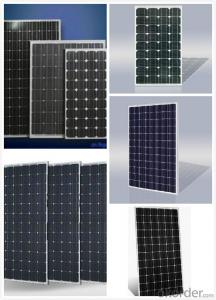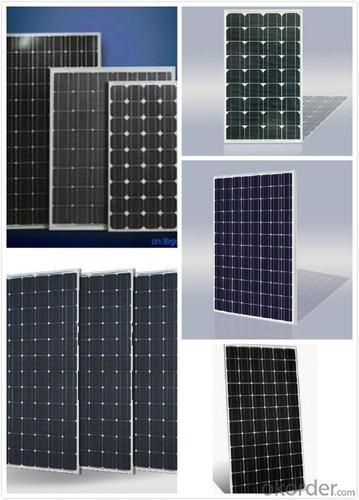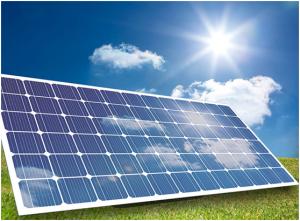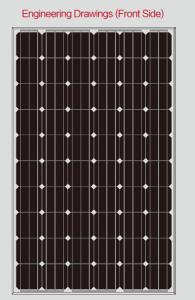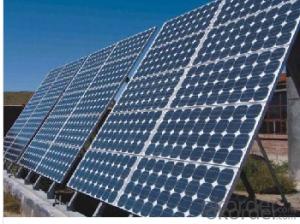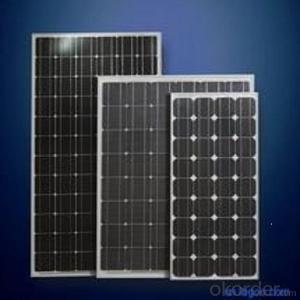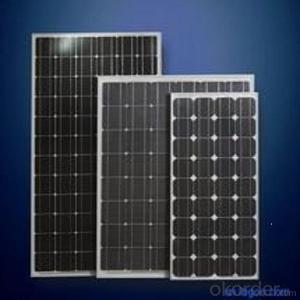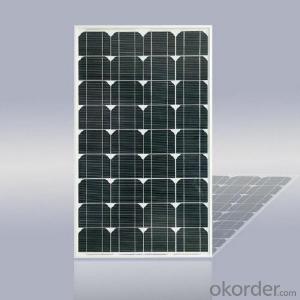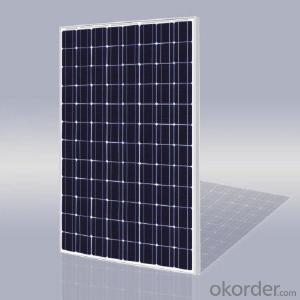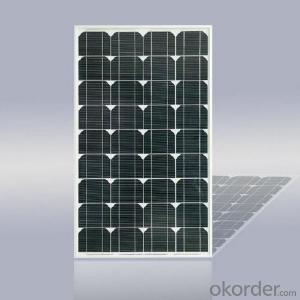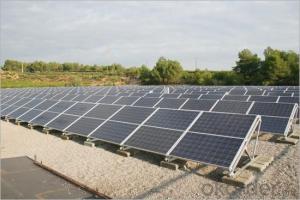Kansas Solar Panels - Solar Panel 260W, High Quality Solar Module
- Loading Port:
- Shanghai
- Payment Terms:
- TT OR LC
- Min Order Qty:
- 2600 watt
- Supply Capability:
- 26000 watt/month
OKorder Service Pledge
OKorder Financial Service
You Might Also Like
Specification
Product Description:
CUSTOMER does not assume responsibility and expressly disclaims liability for loss, damage, or expense arising out of in anyway connected with installation, operation, use or maintenance of the PV modules. No responsibility is assumed by CUSTOMER for any infringement of patents or other rights of third parties that may result from use of PV module.
CUSTOMER reserves the right to make changes to the product, specifications or installation manual without prior notice.
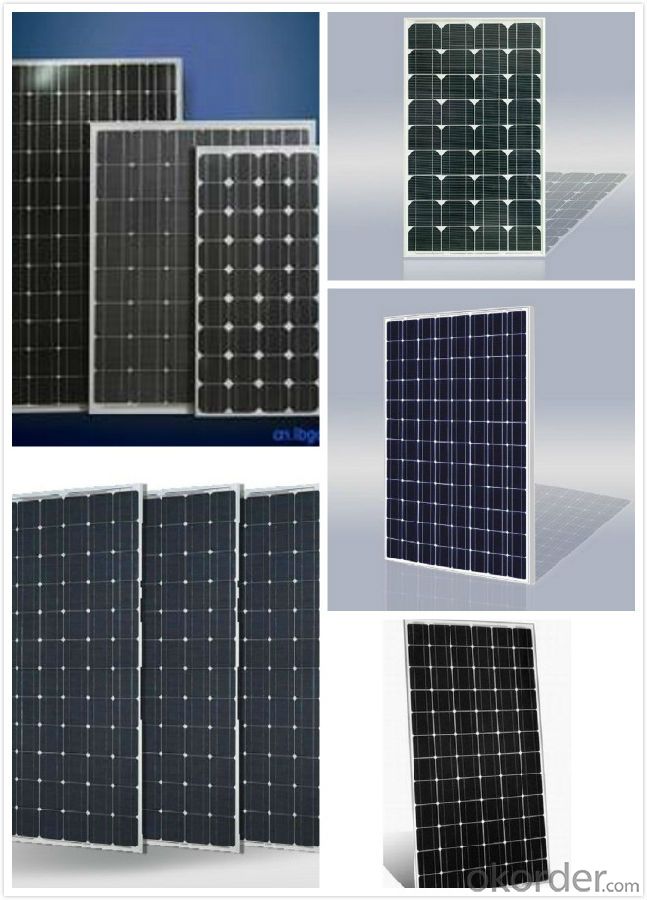
Solar panel working process
In addition to being the ultimate source of all life on earth, the sun is an infinitely renewable, completely pollution-free source of electricity. Instead of burning fossil fuels dug up from the ground in a big power plant – a very 19th century, industrial age approach, when you think about it – solar panels convert sunlight directly into electricity, with no harmful emissions.
The basic unit of a solar panel is a solar cell, which usually consists of one or two layers of silicon-based semiconductor wafers. When struck by the photons in sunlight, the solar cell generates an electrical charge due to the "photovoltaic effect" – which is a pretty good name, since it produces voltage from photons. The flow of these electrons moves in a steady electrical current from one side of the cell to the other.
Dozens of these PV cells are packaged together into solar modules, which in turn are packaged into solar panels that are mounted on a rooftop and arranged to maximize their hours of exposure to direct sunlight. Because the electricity generated by all those solar cells is direct current (DC), it is then sent to an inverter that transforms the power into the same alternating current (AC) used by the appliances in your home and the local utility electricity distribution grid. Increasingly, these inverters are getting "smart," providing data monitoring for solar installation performance and other grid integration services.
FAQ
We have organized several common questions for our clients,may help you sincerely:
③Can you provide the peripheral products of the solar panels, such as the battery, controller, and inverter? If so, can you tell me how do they match each other?
Yes, we can, we have two companies for solar region, one is CNBM International, the other is CNBM engineering Co.
We can provide you not only the solar module but also the off grid solar system, we can also provide you service with on grid plant.
④What is your warranty system?
Our product performance guarantees for 25 years
• 12 years guarantee for workmanship
• Timeliness of delivery
• Quality Products certified (TÜV, UL, CE, ISO)
⑤How do you pack your products?
We have rich experience on how to pack the panels to make sure the safety on shipment when it arrives at the destination.
- Q: My hubby and I are waiting to move in to our camper but have to figure out how many solar panels, batteries, etc. to get. I can't find the info per appliance for Watts and amps, but does anyone have a good, general idea of how many Watts it'd take to run the whole shabang? It's a 999, 25-foot Sportsmen tag-a-long, if that helps..It's got the following, and we'd like to run the propane things off of electric:*Refrigerator/freezer*Microwave*Oven/stove*AC/Heat*Will have a tv, phone chargers, laptop charger, but those will be unplugged when not in useThanks so much! It's such a headache.. You get SO MUCH different info from different places.. OI..
- Running an oven or stove on solar is not a practicality; too much power is needed, use gas. Ditto, heating using solar electricity is not a practicality, and AC would also be asking a lot. The other things, within limits, might be do-able. You'll be needing as many solar panels as you can fit on. If I was you I'd consult a solar installer about how big your battery bank should be once you have decided how many Watts of panels you can put on.
- Q: If a solar panel (using 36 3x6 solar cells) puts out 60 watts, how many panels would I need (for a house) if I use a max of 2300 kWh in a month? I checked my electric usage for the past 2 years and the kWh is usually lower but I wanted to use the most kWh used (2300) for my question. Thanks!
- Good question. Something to keep in mind is that modern solar electric works _alongside_ the grid, so you don't need to displace your entire 2300 kWh. The best financial return, if any, might come at a point where you generate only 500, 000, or 500 kWh per month. How many panels you need strongly depends on your location. Speaking for the location of my house in San Jose, Ca, that amount of usage would be about a 2 kW array, and if you divide 60 into that, you get 200 panels. In a perfect location, you would need slightly less, in a northern state, you might need double that. If this was a real project, you would probably not use 60-watt panels. The choice of panels is not simply a matter of getting enough watts. 2 kW is a large system today for residential. The usual advice is to go for energy efficiency first, then consider solar after the usage is down.
- Q: Can solar panels be used in areas prone to hurricanes or earthquakes?
- Yes, solar panels can be used in areas prone to hurricanes or earthquakes. While these natural disasters can pose risks to solar panels, proper installation and structural reinforcement can ensure their resilience. Additionally, advancements in technology have led to the development of more robust solar panels that can withstand extreme weather conditions. However, it is important to consider local regulations, building codes, and additional safety measures to mitigate potential risks.
- Q: Is it really necessary to make solar panels that expensive?
- Unfortunately, yes. Solar panels require high-grade silicon which is very expensive. Also, volume sales aren't yet high enough to push down prices. Don't worry though, as people buy them and the technology matures it'll get cheaper. I remember DVD players costing $2000+. Now you can get one for less than $30.
- Q: Can solar panels be installed on a shipping container?
- Yes, solar panels can be installed on a shipping container. In fact, many people and businesses are now utilizing shipping containers as a platform for solar installations due to their portability and ease of installation.
- Q: i am starting to consider getting solar panels instead of paying electric bills which are somewhat higher now than they used to be
- Solar power is expensive power. The costs have been coming down but unless it's the only option or there are government subsidies, it would still be less expensive to buy electricity from the grid. The way you compare the upfront costs of solar power with monthly bills is by the Internal Rate of Return equation or the Net Present Value calculation. Vendors will use the payback periods to try and convince you into a financial decision where they reap all the benefits so you need to learn how to do a proper financial analysis. The average US household uses about 950 kwh per month, unless you are very wealthy, you will not be able to afford enough panels for that and you probably don't have enough roof space. You will have to reduce your power usage as much as possible. Batteries are expensive and inefficient. Lead acid batteries are 95% efficient at discharging but only 50% efficient at charging. A battery based system would not only include the costs of the batteries but would also double the number of panels required. Lead acid batteries have their lives rated at only 20% draws on their capacities, they lose a lot of life with each deep cycle. There are deep cycle batteries which have thicker plates but they are also rated at 20% draw and a deep cycle battery's life would drop to 94% with just one deep cycle draw. This means, it's customary to buy five times your diurnal capacity worth of batteries, fortunately this allows for several cloudy days. If you do want to have deep discharges, buy Nickel Iron batteries. You will want a grid tied system instead where you sell the power you produced to the utility and buy back what you need effectively turning the grid into a 00% efficient battery. Of course, there are costs involved as the utilities would likely charge a monthly fee just to be hooked up so this cost must be taken into account. There is also the risk that the utilities may change their net-metering arrangements on you later.
- Q: Can solar panels be installed on shopping malls or retail centers?
- Yes, solar panels can be installed on shopping malls or retail centers. In fact, many commercial buildings are increasingly adopting solar energy systems to reduce their carbon footprint and save on electricity costs. Installing solar panels on shopping malls or retail centers can provide a sustainable and renewable energy source, contributing to their overall green initiatives.
- Q: Can solar panels be used to power a camping trip?
- Yes, solar panels can be used to power a camping trip. They are an excellent source of clean and renewable energy, allowing campers to charge their electronic devices, power lights, refrigerators, and other camping equipment. Solar panels are portable and can be easily set up in a sunny location to harness the sun's energy during the day and store it in batteries for use at night. They provide a sustainable and eco-friendly solution for powering camping adventures.
- Q: Can solar panels be installed on a pergola or awning?
- Yes, solar panels can be installed on a pergola or awning. In fact, these structures can provide an ideal platform for solar panel installation, as they offer ample sunlight exposure and an elevated position that maximizes energy production. Installing solar panels on a pergola or awning can not only generate clean and renewable energy but also provide shade and protection from the elements.
- Q: So idk how to connect a solar panel to a battery ...is it like a series connection from the solar panel to the battery, or a parallel connection from solar cell to battery? (to charge) please and thank you
- it depends how big the panel is. a small trickle charger (like a 2W panel with built-in diode), just connect + to + and - to - (parallel) to trickle charge the battery. The diode will keep the batter from discharging through the panel when there is insufficient sunlight. for a large panel (like a 220W 24v panel), you best go through a charge controller. the charge controller has 2 leads for the solar panel input, 2 leads for the battery connection and 2 leads for the 2v load. just follow the instructions to connect the panel and battery to the controller, and MAKE SURE YOU USE THE REQUIRED FUSES. very straightforward stuff -- just RTFM
Send your message to us
Kansas Solar Panels - Solar Panel 260W, High Quality Solar Module
- Loading Port:
- Shanghai
- Payment Terms:
- TT OR LC
- Min Order Qty:
- 2600 watt
- Supply Capability:
- 26000 watt/month
OKorder Service Pledge
OKorder Financial Service
Similar products
Hot products
Hot Searches
Related keywords
